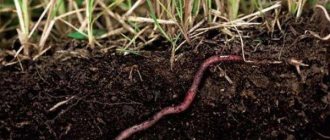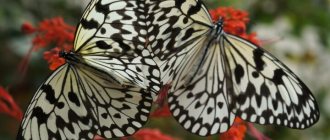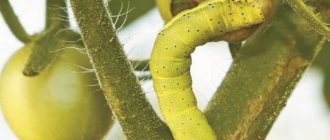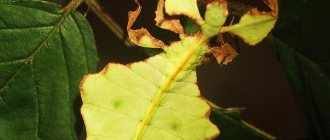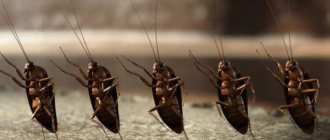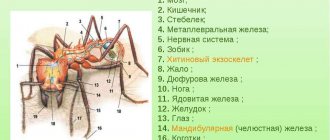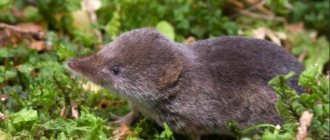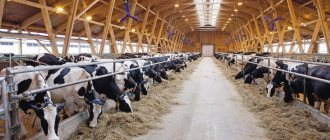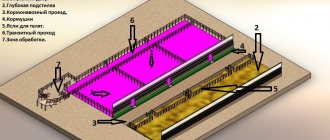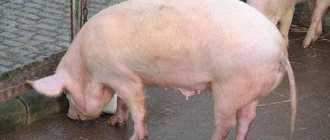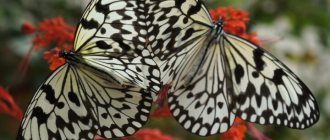Types of butterfly eggs
Butterfly eggs come in various shapes - round, flattened, oval, spindle-shaped, smooth or with a cellular surface, covered with spines or ribs. The color of the eggs is also different, most often whitish, light green or yellow, in addition, brownish, brownish-violet, reddish. The eggs of many species change color as they develop.
The manner in which eggs are laid may differ among different species of butterflies. Eggs can be laid one at a time or several at a time, or in large groups, up to several hundred in one clutch. Eggs can be laid on leaves, stems, flowers, fruits of plants, in cracks in tree bark, on soil, lichens, and on dry plant remains. After laying, females of some species cover their eggs with hairs from their abdomen.
Blue morpho.
Morpho Peleid (Morphopeleides), also called blue or blue morpho.
This diurnal butterfly lives in the Amazon jungle, Central Africa, Peru, Brazil, Ecuador, Colombia and Venezuela. Representatives of this genus are distinguished by their large size, with a wingspan of 13-16 cm. But the main secret of the beauty of these butterflies lies in the special structure of their scales. There are millions of scales on the wings of the morpho, the upper side of which is transparent, and the lower side is blackened with the pigment melanin, which reflects light. These are real microscopic mirrors! On the way back, the light is refracted at different angles and appears to be “split” (a phenomenon known as a rainbow). An optical effect is created. Because of this, the butterfly’s wings have a metallic sheen that either intensifies or fades, depending on the angle at which you look at it. The underside of the wings is decorated with several pairs of eyes of various sizes and is brown in color.
Reproduction and development.
Eggs in the shape of a greenish hemisphere are laid on the leaves of plants. The caterpillar feeds from herbaceous leguminous plants and trees.
The pupa is smooth, shiny, green in color, and its appearance imitates plant fruits.
Blue Morpho is the pearl of the Amazon jungle. In some Indian tribes living in the Amazon, the Blue Morpho is considered a sacred butterfly, since according to legend, it is the messenger of Heaven to Earth and can convey the most secret desires to the Gods.
Caterpillar structure
The body of caterpillars consists of thirteen segments, of which three are thoracic and ten are abdominal. The thoracic segments bear a pair of jointed legs; the abdominal segments usually have five pairs of false legs; some types of abdominal legs have two or three pairs, or they are underdeveloped. The appearance of caterpillars is very diverse and often differs even among closely related species.
Many are brightly and variegatedly colored, some have outgrowths in the form of horns, spikes, and bumps. The surface of the body is smooth with sparse scales or covered with dense hairs, warts, and spines. Body proportions also vary: some caterpillars are short and thick, others are thin and long.
Parasitic wasps and flies
If the caterpillar stops moving and suddenly develops a small white rash, this is bad. Very often, caterpillars are attacked by tiny wasps or flies. These parasites lay eggs, and then tiny wasps or fly larvae live by feeding on the insect's internal fat, but this does not kill the caterpillar.
Over time, these small wasp or fly larvae become larger and larger. When it's time to spin cocoons, small larvae leave the caterpillar's skin and make cocoons on the surface. The white rash is the cocoons of parasitic wasp larvae. Soon they will hatch, turn into small black wasps and fly away to repeat the process.
To read: Causes and treatment of ear mites in humans
If the insect has become a stationary brown pupa, then all its cells turn into an adult butterfly or moth. If the insect is truly dead, it will dry out and turn into a slightly shriveled "raisin" then it's time to say goodbye. But usually it’s just rest and metamorphosis.
What do caterpillars eat?
Caterpillars of most butterfly species feed on green parts of plants - leaves, flowers, unripe fruits. Some develop inside branches and trunks, feed on wood, on lichens and dead parts of plants, on animal remains such as wool, down, feathers, and also on wax.
Some species are predatory, feeding on ant larvae and scale insects.
Main suborders
Primary toothed moths are small butterflies with a wingspan of four to fifteen millimeters. Representatives of the suborder include small-winged golden and marigold
Proboscisless. The size of the wings is no more than twenty-five millimeters.
Proboscis. The suborder is represented by several dozen families. This suborder has a very varied appearance and is very diverse
Transformation of a caterpillar into a butterfly - the pupa stage
Pupation is the most vulnerable process in the butterfly's development cycle, and most caterpillars prepare carefully for it. The pupal stage in different species can last from several days to several years. A long pause (stop in development) of pupae is an adaptation that allows the species to survive unfavorable years. If in the first year unsuitable conditions arise and the butterflies emerging from the pupae die, the population is replenished by previously diapausing pupae that emerge the next year.
The butterfly formed inside the pupal shell has very short, soft wings. When emerging from the pupa, it needs to climb onto some vertical surface in order to hang its wings, which will give them the opportunity to straighten. After which the wings gradually harden, and during this time the butterfly sits motionless.
Conversion process
How long it takes for a caterpillar to turn into a butterfly while in a cocoon depends on climatic conditions and the type of insect. From a few days to 14 years. Moths in our area appear on average after 15 days.
What is the name of the process of transformation of a caterpillar - metamorphosis. More precisely, holometamorphosis, since some parts of the larva remain. In this case - paws. Experts understand this term as a complete degeneration of forms. Just as a plastic bottle is melted, a glass is then made.
In a cocoon that appears completely motionless, complex processes take place inside. The body splits and turns into a liquid mass with imaginal discs. To make it clearer, these are similar to stem cells, and any organs or tissues can be formed from them.
Upon completion of the process of transformation from a caterpillar to a butterfly, the formed insect secretes a special secretion, which allows the walls of the cocoon to be split. Initially the head is shown, then the body, legs. The newborn insect sits motionless for several minutes, waiting for its wings to dry. Then he straightens them and begins to search for the opposite sex for mating.
Butterfly structure
The butterfly's body consists of three sections - the head, thorax and abdomen, which contains internal organs.
The head bears antennae, palps, complex compound eyes and mouthparts. The vast majority of butterflies have mouthparts of the sucking type and are a thin long tube-proboscis, which is curled into a spiral when at rest. Many butterflies have underdeveloped mouthparts and are thus unable to feed, subsisting on energy reserves accumulated during the caterpillar stage.
The antennae of butterflies are an organ of smell and come in various shapes - filamentous, club-shaped, feathery, comb-shaped and others. The sense of smell of some butterflies is very developed; males of such species are able to detect the scent of a female at a considerable distance.
The chest of butterflies bears three pairs of jointed legs and two pairs of wings, while the females of some species have underdeveloped wings or are completely wingless, and in some species they are also legless. The pattern on the wings of butterflies is formed by the scales covering them, hence the scientific name of the order - Lepidoptera.
What happens during metamorphosis
Juvenile hormone delays metamorphosis at the larval stage. It works by blocking genes in imaginary discs—tiny disc-shaped sacs that are triggered when the caterpillar wraps itself into a chrysalis and turn into the butterfly's antenna, eye, wing or other element. Thus, the hormone is necessary for survival until metamorphosis.
As soon as the larva undergoes its final molt and metamorphosis begins, strange things happen to its body. Cells in the muscles, intestines and salivary glands are digested and serve as “spare parts” for the future butterfly. Every cell is programmed to destroy itself through the activation of enzymes called caspases.
Caspases are ruptured by a protein in cells, releasing the basic material to create butterflies. If not for the juvenile hormone, this could have happened at any time, killing the insect. Instead, nature programmed it to lower its level at the ideal moment for metamorphosis.
With less juvenile hormone, pupation occurs instead of regular molting.
Once the caterpillar has expanded all its tissues except the imaginal discs, they use the protein-rich broth that surrounds them to stimulate the rapid cell division necessary to form the wings, antennae, legs, eyes, genitals and other elements found in an adult butterfly or moth. For example, an imaginary fruit fly wing disk may initially consist of 50 cells and increase to more than 50,000 cells by the end of metamorphosis.
Metamorphosis is more than just a stunning physical transformation. This is a clear demonstration of the evolutionary mechanism. Butterflies and caterpillars not only differ strikingly in appearance, but also behave differently. The caterpillar lives on a tree, and the butterfly flutters. The first eats leaves, and the second feeds exclusively on nectar.
There are many opportunities for coexistence in an ecosystem as long as they do not encroach on each other's food supplies.
Types of butterflies
The color of butterfly wings is varied. In some they are beautifully and brightly colored, while in others, on the contrary, they have a modest protective color, allowing them to be invisible on flowers and herbs, tree bark, stones, and lichens. Many species are characterized by sexual dimorphism, that is, a pronounced external difference between male and female in color, shape and size of wings, as well as in the structure of the antennae. Occasionally there are individual, atypically colored individuals called aberrants.
Gynandromorph butterflies, that is, individuals that combine the characteristics of a male and a female, are extremely rare. Gynandromorphs of species that are characterized by pronounced sexual dimorphism look very unusual. In this case, on one side of the butterfly’s body there are wings with the color of the male, and on the other - with the color of the female.
Most butterflies are active at dusk and at night, with a much smaller number of species active during the day. However, it is the diurnal butterflies that are the most visible, and, as a result, the best studied. Many butterflies are good flyers; some species are characterized by regular migrations, which often leads to their wide distribution. Others, on the contrary, inhabit only small geographical regions; such species are called endemic.
Caligo.
Caligo (lat. Caligo - “gloomy”).
This butterfly lives in the dense tropical forests of the Amazon, Peru, Brazil, and Colombia. During the day she hides in the shadows. Her daily activity lasts no more than 20 minutes in the morning and evening twilight. The largest representatives of Caligo reach a size of 20 cm. The lower part of the wings has eyes very similar to the eyes of an owl, and also strongly resembles the skin of a snake. This coloring helps it scare away predators. And the upper part of the wings is painted in beige, yellow and bluish tones, smoothly blending into each other. As a nocturnal moth, Caligo has ultrasonic hearing and voice. It emits ultrasonic waves and a human-audible crackling sound to repel bats. Caligos feed on the juice of overripe fruits, with particular preference for overripe bananas.
The mosaic pattern on the Caligo butterfly egg looks like a space landing pad. Egg laying is usually small on plant leaves. The food plant of the caterpillars is heliconia and plants of the banana genus. The caterpillars live in joint groups and are nocturnal, hiding along the main vein of the leaf during the day.
The pupa is brown in color, has a rough surface, shaped like a “boot”, and looks like a dried leaf.
Caligo, who accidentally flew into the house, is considered a symbol of good luck and family happiness.
